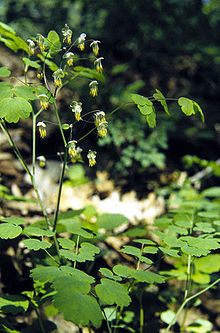Thalictrum dioicum
| Thalictrum dioicum | |
|---|---|

| |
| Scientific classification | |
| Kingdom: | Plantae |
| Clade: | Tracheophytes |
| Clade: | Angiosperms |
| Clade: | Eudicots |
| Order: | Ranunculales |
| Family: | Ranunculaceae |
| Genus: | Thalictrum |
| Species: | T. dioicum
|
| Binomial name | |
| Thalictrum dioicum | |
Thalictrum dioicum, the early meadow-rue[1] or quicksilver-weed, is a species of herbaceous plants in the family Ranunculaceae. Plants are typically upright growing woodland natives from Colorado Rocky Mountain forests to central and eastern North America including parts of south eastern Canada. This species has dioecious plants, with male and female flowers on separate plants blooming in early to mid spring.
Thalictrum dioicum grows from 30 to 80 cm tall, from upright caudex, with yellow-gold colored – thick fibrous roots. New caudexes are generated each year by the current years plant and the old caudex withers away in the fall and early spring of the next year. In early spring plants grow, producing glabrous or glandular leaves. both basal and cauline leaves are produced that have long petioles. Leaf blades are 1-4×-ternately compound with leaflets reniform or cordate to obovate or orbiculate in shape. The leaflets are 10–45 mm wide with lobed margins often crenate, and the undersides are normally glabrous or glandular. Inflorescences are panicles or corymbs produced terminally and axillary with many flowered branches. The flowers have no petals but have greenish colored, 1.8–4 mm long sepals sometimes tinted purple. The sepals are ovate to obovate or oval in shape. On male plants, the flower filaments are the most showy part of the hanging flowers, being yellow to greenish yellow in color and 3.5-5.5 mm long. The filaments end in anthers 2–4 mm long that are mucronate to acuminate in shape with purple colored stigma. After blooming, female plants if fertilized, produce green fruits called achenes. Each flower that is fertilized typically produces (3-)7 to 13 achenes that are not reflexed and sessile or nearly so in tight clusters. The achenes are ovoid to ellipsoid in shape and not laterally compressed, 3.5–5 mm long, glabrous, very strongly veined, with 1.5 to 3 mm long beaks, ripening in mid summer.[2]
Plants are grown in shade gardens for their attractive lacy foliage that is reminiscent of columbines or maiden hair fern. The males produce more showy flowers than the female plants, blooming in early spring with the flowers and foliage rising out of the ground in club-like clusters with the basal leaves unfolding first. Plants start to flower before the compound leaves have completely unfolded. This species, like some others of its genus, is pollinated via wind action (anemophily).[3] Males start off the year taller than the females, but as the fruits grow females are taller typically in summer.
References[edit]
- ^ USDA, NRCS (n.d.). "Thalictrum dioicum". The PLANTS Database (plants.usda.gov). Greensboro, North Carolina: National Plant Data Team. Retrieved 9 December 2015.
- ^ Park, Marilyn M.; Festerling Jr., Dennis. "Thalictrum dioicum". In Flora of North America Editorial Committee (ed.). Flora of North America North of Mexico (FNA). New York and Oxford: Oxford University Press – via eFloras.org, Missouri Botanical Garden, St. Louis, MO & Harvard University Herbaria, Cambridge, MA.
- ^ Steven, Janet; Waller, Donald (2004). "Reproductive alternatives to insect pollination in four species of Thalictrum (Ranunculaceae)". Plant Species Biology. 19 (2): 73–80. doi:10.1111/j.1442-1984.2004.00103.x. Retrieved 6 December 2018.
External links[edit]
 Media related to Thalictrum dioicum (category) at Wikimedia Commons
Media related to Thalictrum dioicum (category) at Wikimedia Commons Data related to Thalictrum dioicum at Wikispecies
Data related to Thalictrum dioicum at Wikispecies
- NatureServe secure species
- Thalictrum
- Flora of the Eastern United States
- Flora of Eastern Canada
- Flora of the Northeastern United States
- Flora of the Southeastern United States
- Flora of the Appalachian Mountains
- Flora of the Rocky Mountains
- Plants described in 1753
- Taxa named by Carl Linnaeus
- Dioecious plants

